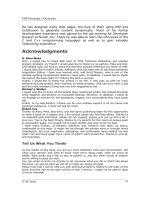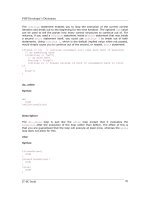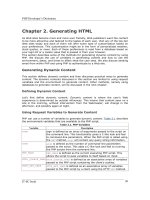PHP Developer''''s Dictionary- P42 potx
Bạn đang xem bản rút gọn của tài liệu. Xem và tải ngay bản đầy đủ của tài liệu tại đây (438.22 KB, 5 trang )
PHP Developer’s Dictionary
IT-SC book
205
string imap_body(int imap_stream, int num, [int flags]);
Description
The
imap_body()
function returns the body of the message specified by num
from the
mailbox connected to by imap_stream . This function takes some optional flags ,
which is a bit mask of one or more of the items in Table 6.1
.
Table 6.1. Values for the
flags
Parameter
Value
Description
FT_INTERNAL
Specifies the return string is in internal format. This forces it not to
standardize to CRLF.
FT_PEEK
Tells the request not to set the \ Seen flag, assuming that it is not
already set.
FT_UID
Specifies that
num
is the UID and not the message ID.
imap_check()
Syntax
object imap_check(int imap_stream);
Description
The
imap_check()
function returns an object with various properties that define the
mailbox connected to by imap_stream . These properties are as follows:
•
Date—Contains the last change of the mailbox contents.
• Driver—Returns the protocol used to access this mailbox, which could be
POP3, IMAP, or NNTP.
•
Mailbox—Gives you the name of the mailbox.
•
Nmsgs—Returns the number of messages in the mailbox.
• Recent—Returns the number of new messages in the mailbox.
If the function fails,
FALSE
will be returned.
imap_clearflag_full()
Syntax
PHP Developer’s Dictionary
IT-SC book
206
string imap_clearflag_full (int imap_stream, string sequence, string
flag,
string options);
Description
The
imap_clearflag_full()
function, which was added in PHP 3.0.3, clears the
flags on a message connected to by imap_stream. The flags can be any of the
entries in the following list. (You can check Request For Comments (RFC) 2060 at
/> for more information on these flags.)
• \\Seen
•
\\Answered
• \\Flagged
•
\\Deleted
• \\Draft
•
\\Recent
The options
field contains a bit mask with one or more
ST_UID
s, which are sequence
arguments that contain UIDs instead of sequence numbers.
imap_close()
Syntax
int imap_close(int imap_stream [, int flag])
Description
The
imap_close()
function closes the previously opened imap_stream . This function
takes an optional
CL_EXPUNGE
flag that will cause the removal of all messages
marked for deletion.
imap_createmailbox()
Syntax
int imap_createmailbox(int imap_stream, string mailbox)
PHP Developer’s Dictionary
IT-SC book
207
Description
The imap_createmailbox() function creates a new mailbox, named mailbox , on
the system connected to by imap_stream . The function returns
1
if successful, or
0
if unsuccessful.
imap_delete()
Syntax
int imap_delete(int imap_stream, int message_num [, int flag])
Description
The
imap_delete()
function, which returns
1
if successful, marks the message
located at message_num for deletion. The optional flag is
FT_UID
and tells the
function to treat message_num as a UID.
After you have marked messages for deletion, you must either call the
imap_expunge()
function, or pass
CL_EXPUNGE
to
imap_close()
when closing the
connection, to delete the marked messages.
Tip
If you are connecting to a POP3 mailbox, you need to expunge your
marked messages before you close your connection. Marked deletions are
not carried across connections as in IMAP.
imap_deletemailbox()
Syntax
int imap_deletemailbox(int imap_stream, string mailbox)
Description
The
imap_deletemailbox()
function deletes the specified mailbox
from the
imap_stream . If successful,
1
is returned; otherwise, a
0
is returned on error.
Tip
Check out
imap_open()
for more information on the formatting of mailbox
names.
PHP Developer’s Dictionary
IT-SC book
208
imap_errors()
Syntax
array imap_errors()
Description
The
imap_errors()
function, which was added in PHP 3.0.12, is an array of all the
error messages that have been generated since the beginning of the page or the last
time you called the function.
imap_expunge()
Syntax
int imap_expunge(int imap_stream)
Description
The
imap_expunge()
function removes all messages marked for deletion in the
mailbox connected to by
imap_stream
. Messages can be marked using the
imap_delete()
,
imap_move_mail()
, or
imap_setflag_full()
functions.
imap_fetch_overview()
Syntax
array imap_fetch_overview(int imap_stream, string sequence [, int
flag])
Description
The
imap_fetch_overview()
function, which was added in PHP 3.0.4, grabs the
message headers for a given sequence and returns an overview of their contents.
The sequence
is a list of message IDs unless flag
is set to
FT_UID
, in which case it
represents UIDs.
The array returned is an array of objects with the properties specified in Table 6.5
.
Table 6.5. Object Properties
PHP Developer’s Dictionary
IT-SC book
209
Property
Description
subject
The subject of the messages.
from
Who sent the message.
date
When the message was sent.
message_id
The message ID.
references
A reference to this message ID.
size
Size of the message in bytes.
uid
UID of the message in the mailbox.
msgno
Message sequence number in the mailbox.
recent
The message has been flagged as recent.
flagged
The message has been flagged.
answered
The message has been flagged as answered.
deleted
The message has been flagged for deletion.
seen
The message has been flagged as read.
draft
The message has been flagged as a draft.
The following example shows how you can grab messages 1–3 and 7 using this
function.
$overview = imap_fetch_overview($mailbox,"1:3,7",0);
imap_fetchbody()
Syntax
string imap_fetchbody(int imap_stream, int num, string part_num
[, flags flags])
Description
The
imap_fetchbody()
function will fetch the part—defined by part_num
—of the
message at num . You can optionally pass one or more of the flags in Table 6.2
to
complete this procedure.
Table 6.2. Values for the
flags
Parameter
Value
Description
FT_INTERNAL
Specifies the return string is in internal format. This forces it not to
standardize to CRLF.
FT_PEEK
Tells the request not to set the
\ Seen
flag, assuming that it is not
already set.
FT_UID
Specifies that
num
is the UID and not the message ID.
Note









